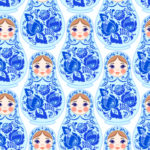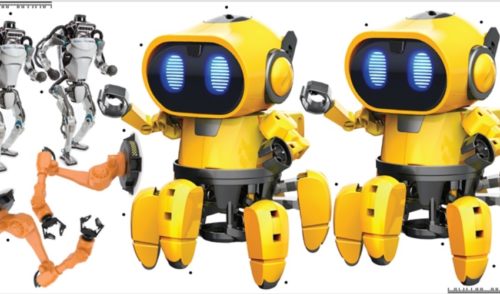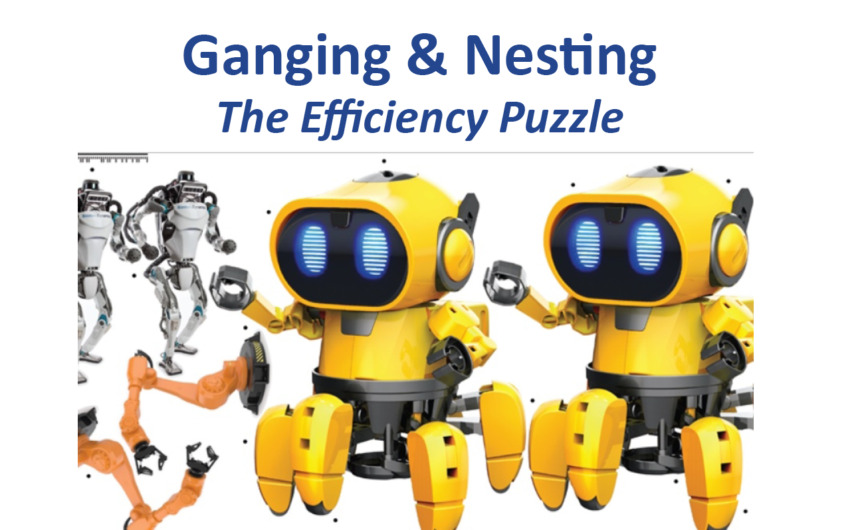Most printers understand the value of combining jobs to reduce waste and create production efficiencies. The more you can combine on to a single sheet, the less waste you have. Even in roll-to-roll printing, there are efficiencies to be gained by grouping jobs. It has been the go-to efficiency technique for printers for years, yet it isn’t common practice in many digital print shops. It should be!
Nesting is the layout technique that attempts to put the content on the sheet to minimize waste. Labels, tickets, cards, and all manner of irregularly shaped print can be positioned in orientations and at angles that maximize the number of objects filling the available space. These nesting doll tags below show how the images are laid out to maximize the number of dolls.

(Shutterstock Image)
Nesting is normally associated with sheetfed printing, but the technique is managed in prepress and can be appropriate for a variety of sheetfed and some roll-fed production. When nesting for print on roll-fed presses, layouts might be modified to accommodate where sheeting breaks will happen. Today, these sheets are often finished by motion cutters programmed to efficiently make the needed cuts.
Ganging takes the idea of nesting a step deeper. Where nesting involves the same image artfully placed, ganging brings in a variety of files destined for the same substrate. This is not a new practice in most printing segments. Transaction printers have done a form of this for years by printing different jobs side-by-side on roll-fed presses, while in commercial, label, and some packaging environments this is a common print set-up.

Ganging illustration is from Tilia Labs.
Before you dive into ganging, there is a quick caveat. Nesting involves the same image, same color model, and same saturation. The odds are good that your digital inkjet device will hold the colors without ghosting or other anomalies. The advantage it brings is the optimized use of the substrate. When you get into ganging, carefully consider what will share the same sheet.:
Do the elements you intend to gang contain heavy, solid colors. For example, one might have a large block of solid red and another a block of solid teal. Depending on your production environment, you might find that when you go into production there are challenges with color balance, drying or image transfer. Consider running a test if you have distinctly different saturation among your ganged content. Remember that ganging elements with different cutting paths for finishing may be best accomplished with motion cutters versus die cutting equipment.
Many smart shops use both nesting and ganging to optimize their throughput and keep their production costs as low as possible. In years past you might have seen nesting and ganging done manually at a light table, but in 2020 there are more efficient options! You may already own them!
Tools for Nesting and Ganging
There are dozens of software solutions for ganging, nesting, tiling, and imposition in the market. Some come as part of larger solution suites, like those that are part of the Esko Automation Engine or features that are part of the Fiery Command Workstation. Others are part of workflow solutions for specific applications, and others are general purpose. Most were built for offset, sheetfed environments, but the software doesn’t know how you will use it!
As you do your research, look for tools that include Artificial Intelligence (AI). As much fun as going through what-if scenarios during production planning can be, AI-driven ganging and nesting can find the best solution based on criteria you assign, saving hours in the process. Dig into your installed solutions to see if they current support AI-based ganging and nesting. If you find that they do not, check with your vendor to see if there is an upgrade available today, or if they have new features on a roadmap.
Many vendors support imposition, nesting, ganging, and tiling solutions to help you build your most efficient workflow. Ultimate Technographics supports nesting and gang-run layouts with some AI capabilities, and is commonly found in digital print environments due to their extensive partner network. Tilia Labs, Caldera, and others also support AI-driven ganging and nesting solutions. If you run a Prinergy workflow, you may already be using PerfectPattern for your AI-driven ganging and nesting.
Whichever solution you use, remember to map these efficiencies into your estimating and quoting models. Some printers offer a discount for allowing work to be ganged because it may change delivery or substrate options. Even if you don’t offer a discount, ensure that the efficiencies you gain in production are reflected in how you capture your data to set your margins.
Should you consider adding ganging and nesting techniques to your production workflow? Absolutely! Do your homework and reap the rewards of production efficiency.
Remember, there are a million questions in inkjet city! Have a question for Pat? Get in touch.

